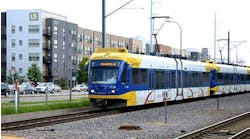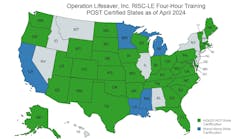As a highlight of the Federal Transit Administration's First Streetcar Conference, FTA Administrator Peter Rogoff today showcased Portland's Moody Avenue reconstruction project as an example of how well-planned and executed transit projects may serve as a catalyst for economic development. The two-day roundtable discussion was held to assist transportation planners from11 cities around the country to learn how to best implement federally-funded streetcar projects in their communities.
"The reconstruction of Moody Avenue demonstrates how investment in transit can create a ripple effect, stimulating development and creating jobs while easing congestion and improving our environment," said U.S. Transportation Secretary Ray LaHood, who was in Portland last March to help break ground for the project.
In addition to greatly expanding transportation options in the area, the project unlocks development of Portland's largest piece of vacant land in the central city. With new utilities installed and new streetcar, roadway, bicycle and pedestrian connections built, Moody Avenue will serve the planned development of a 43-acre site owned by Zidell Marine Corp., as well as Oregon Health and Science University's 18-acre Shnitzer Campus, home to the 480,000 square-foot Collaborative Life Sciences Building, which will integrate Moody Avenue Light Rail Station into its construction and development.
"The city of Portland and TriMet have hit a home run with this project and demonstrate the enormous economic benefits transit can deliver to a community," Administrator Rogoff said. "Two hundred-fifty people have been put to work converting a site that once was a toxic Brownfield into a thriving transportation and business corridor."
The Portland streetcar effort is a victory for the city and its residents and federal investments in streetcar systems across the country are reinvigorating an industry that until recently no longer existed in the United States for many decades. The streetcars will be manufactured in Portland by United Streetcar, a subsidiary of Oregon Iron Works, evidence of the industry's rebirth.
ArcelorMittal, located in Steelton, Pa., has become the first domestic steelmaker to enter an emerging market for so-called block rail — a product that is being used, for the first time in the United States, to help build the new Portland streetcar line. ArcelorMittal employees 700 employees in Steelton, and the streetcar revival may one day eliminate the need to import streetcar rail from foreign countries.
Rogoff was joined by Portland Mayor Sam Adams, Portland Bureau of Transportation Director Tom Miller, TriMet General Manager Neil McFarlane and conference attendees on a tour of the reconstruction effort, which was funded in part by a $23 million grant from the American Recovery and Reinvestment Act's TIGER (Transportation Investment Generating Economic Recovery) program.
The Recovery Act funds were used to create dual streetcar tracks, widening Moody Avenue, and raising it up 14 feet in order to link with a transit bridge that accommodates streetcar, light rail, bus, bicycle and pedestrian traffic. Raising the street also allowed surrounding land, which had been designated a Superfund cleanup site, to be capped, opening up the large parcels of land for development.
The project is truly multi-modal, bringing bus and light rail service to the neighborhood, strengthening connections to the Portland Aerial Tram and Portland Streetcar, and enhancing bicycle and pedestrian access.
Rogoff also announced that the Portland area will now also have access to a $2 million grant to study the Southwest Corridor, which has been locally identified as the next corridor in the area for a major transit investment. The funds were originally announced in 2010.


